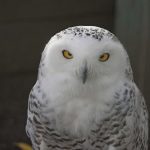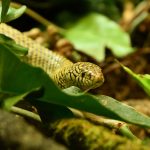Scientific research is critical for developing our understanding of animal behaviour and welfare. Imagine trying to understand the world through the eyes of an emu, a harbor seal, or even a chickadee. That’s exactly why the Edmonton Valley Zoo is so excited to be part of a groundbreaking research project led by Dr. Jenna Congdon! Dr. Congdon’s findings are changing the way we see animal cognition.
As a Canadian Association of Zoos and Aquariums (CAZA) accredited facility, the Edmonton Valley Zoo consistently dedicates itself to educating visitors, staff, and animal lovers on conservation efforts and society’s environmental impact. Here, scientific research isn’t just a side project – we’re always striving for more as we care for our animals and contribute to global conservation efforts. At the heart of this commitment is researchers like Dr. Congdon.
Dr. Congdon’s love for animals goes without saying, and can be observed in her time spent working with Toronto Zoo studying Sumatran orangutans. Evidently, she has had a variety of research experience throughout her career but cites her work with black-capped chickadees as her most successful endeavour, where she investigated how these songbirds change their vocalizations based on perceived predator threat.

Unlocking the Secrets of “Global” vs. “Local” Thinking
Dr. Congdon’s current project, a collaboration between the Edmonton Valley Zoo and the Franklin Park Zoo, began with the initiative to analyze how animals process information. Do animals process information by focusing on the “whole” (global) or specific details (local)? Processing biases influence how a human brain interprets information – we filter information based on our attention and environmental pressures that influence our day-to-day lives. While numerous studies have been performed across a variety of species, there are many understudied species that contain critical pieces to the puzzle.
The Experiment: A Peek Inside Animal Minds
Through an international partnership with Dr. Suzanne Gray (Franklin Park Zoo), who initiated this type of research with such species as kea, umbrella cockatoo, citron-crested cockatoo, pygmy falcon, white-crowned hornbill, and emus, Dr. Congdon’s team has designed touchscreen apparatuses and conducted training for emu, harbour seals, and fur seals.
Each animal participates in training, then six phases of testing with a variety of visual stimuli that allows for researchers to compare different rates of learning within animal species. Each animal makes discriminations by touching an image on the screen, all while a computer keeps the researchers blind to what’s being shown – ensuring the validity of each trial. And, of course, there are tasty food rewards to keep everyone motivated!
Early Findings: What the Animals Are Telling Us
While the results are still preliminary, emus seem to be “local” thinkers, focusing on the details. Harbor and fur seals, on the other hand, are anticipated to be more “global” in their approach. And keep an eye out for our otters – once the pups grow a bit, maybe they can participate too!
Why This Matters
Dr. Congdon’s research is fascinating, as well as rather complicated to most. By understanding how animals think, we can better meet their needs. The Edmonton Valley Zoo is thrilled to be supporting this research, witnessing the discoveries Dr. Jenna Congdon and her team make. Without researchers such as Jenna, humans would struggle to understand the specific needs of animal species, such as food and habitat preferences, adaptations, and welfare requirements, and we cannot wait to witness what her findings bring to the benefit of animals!













